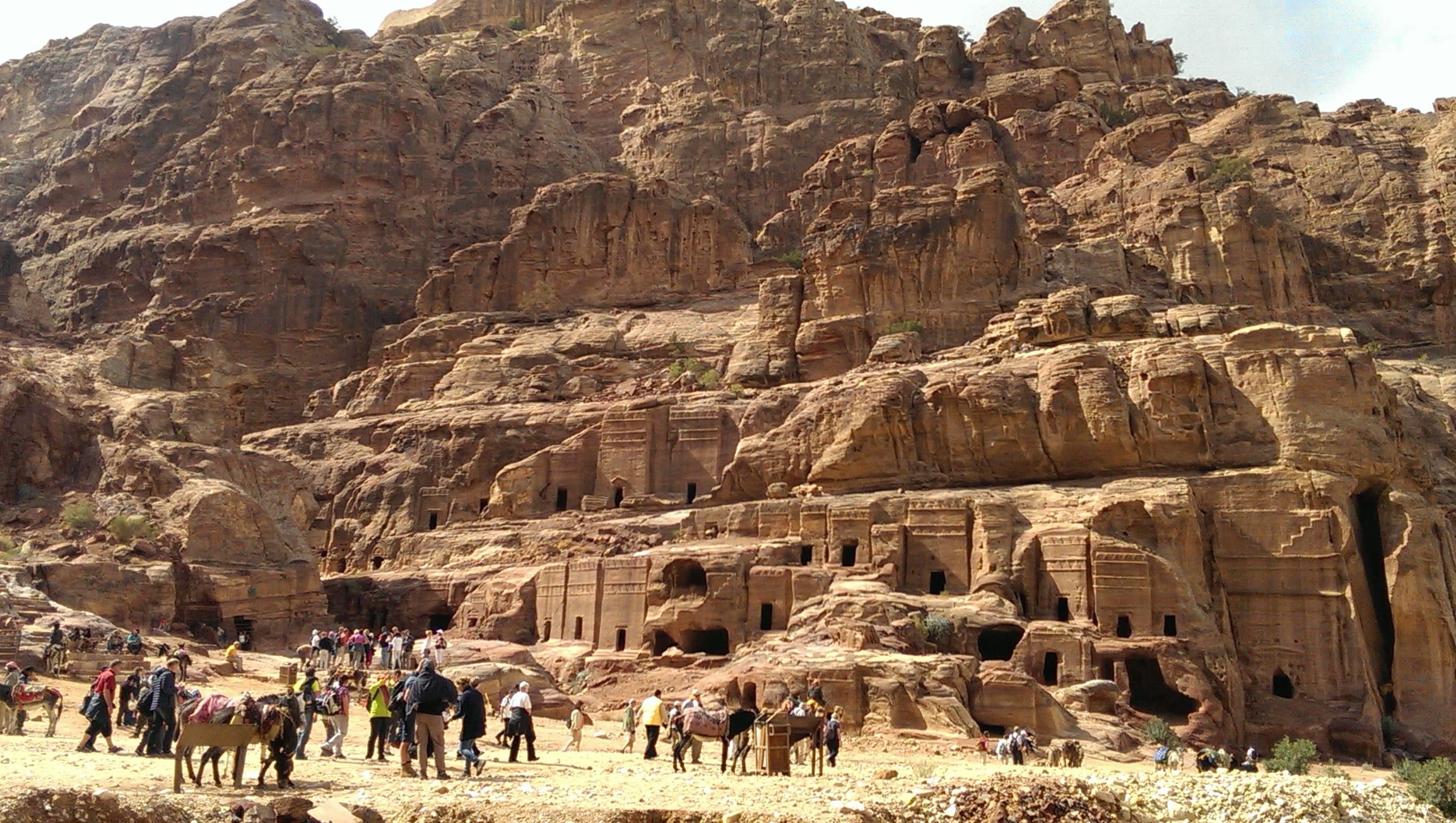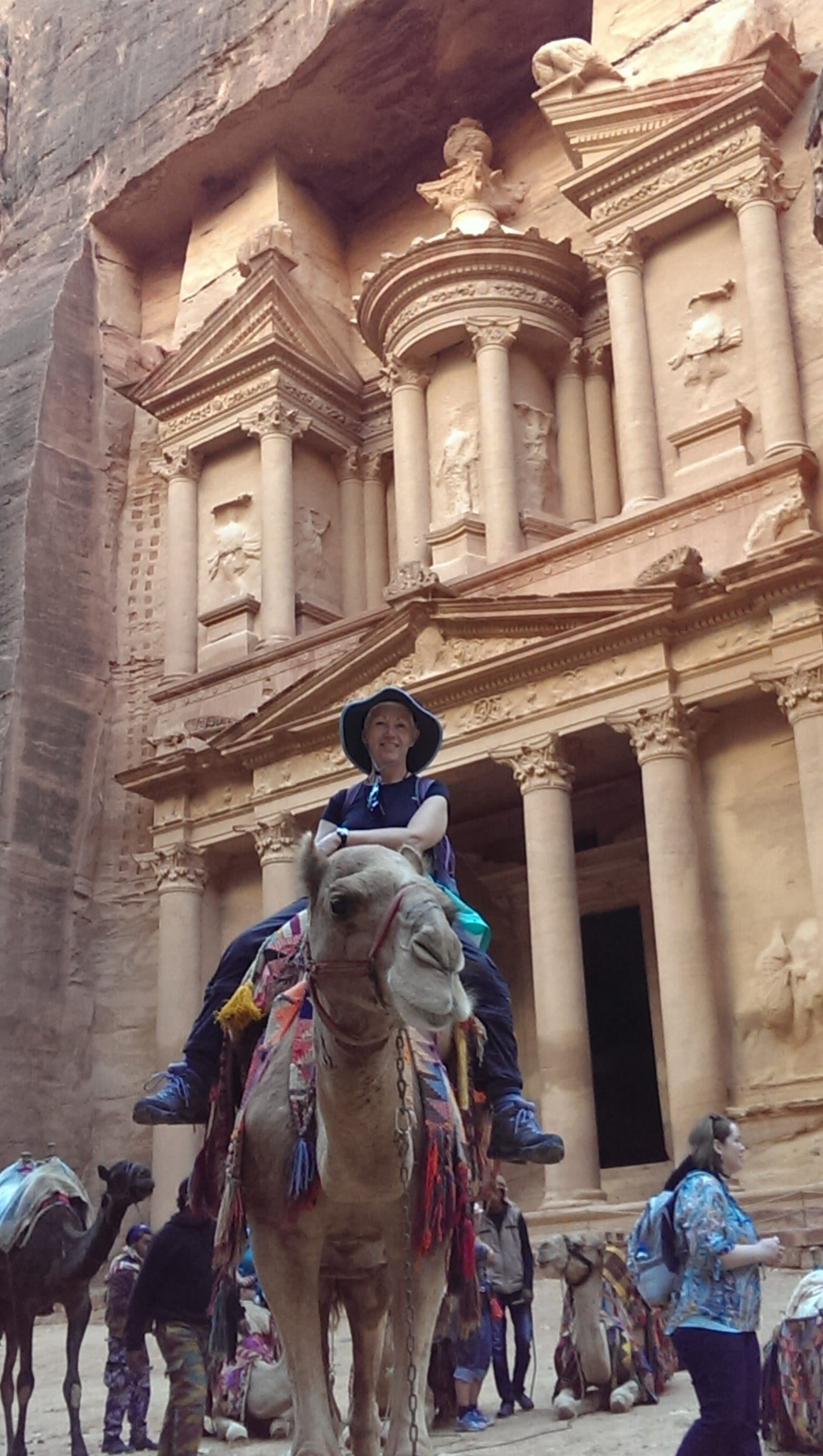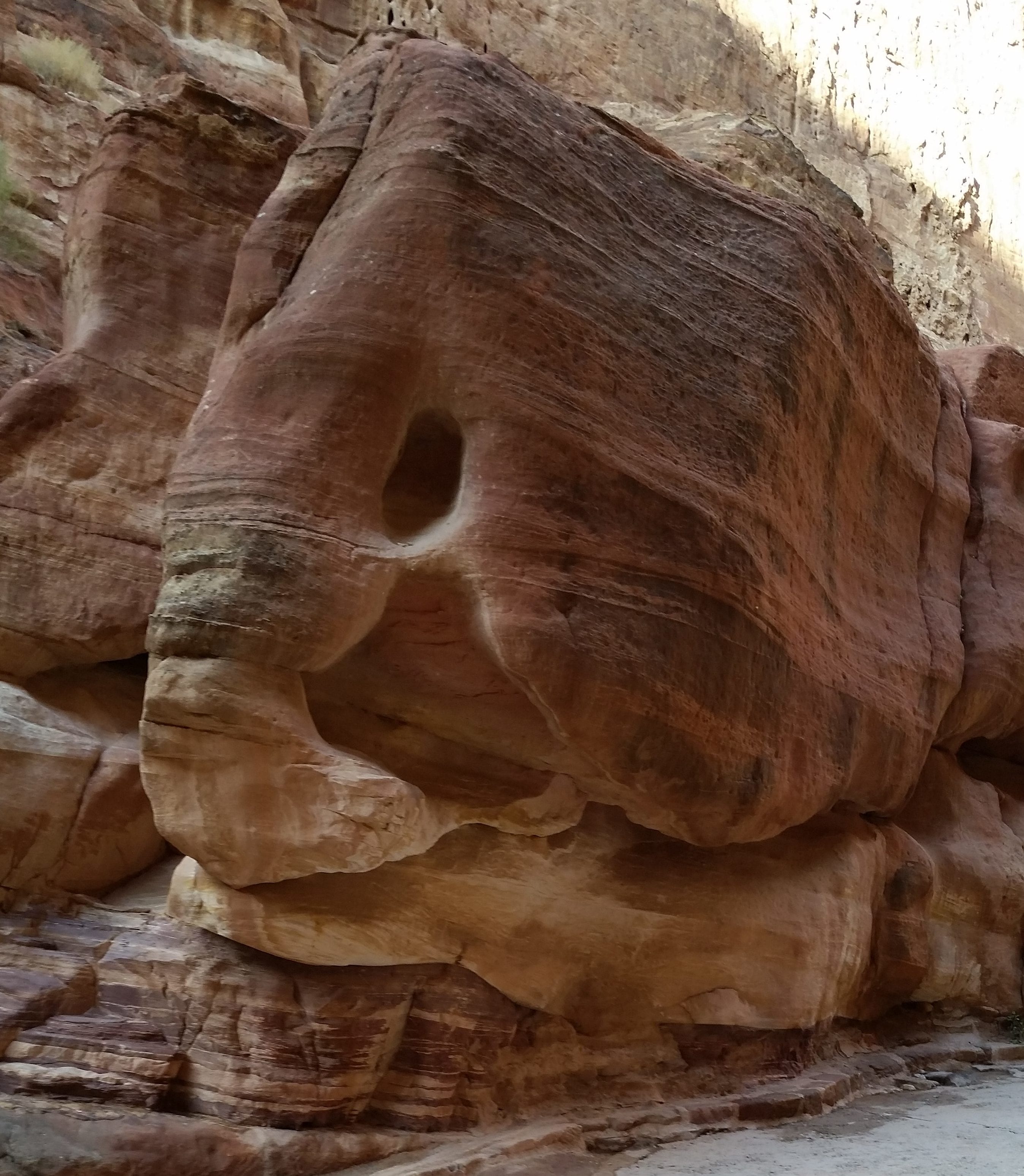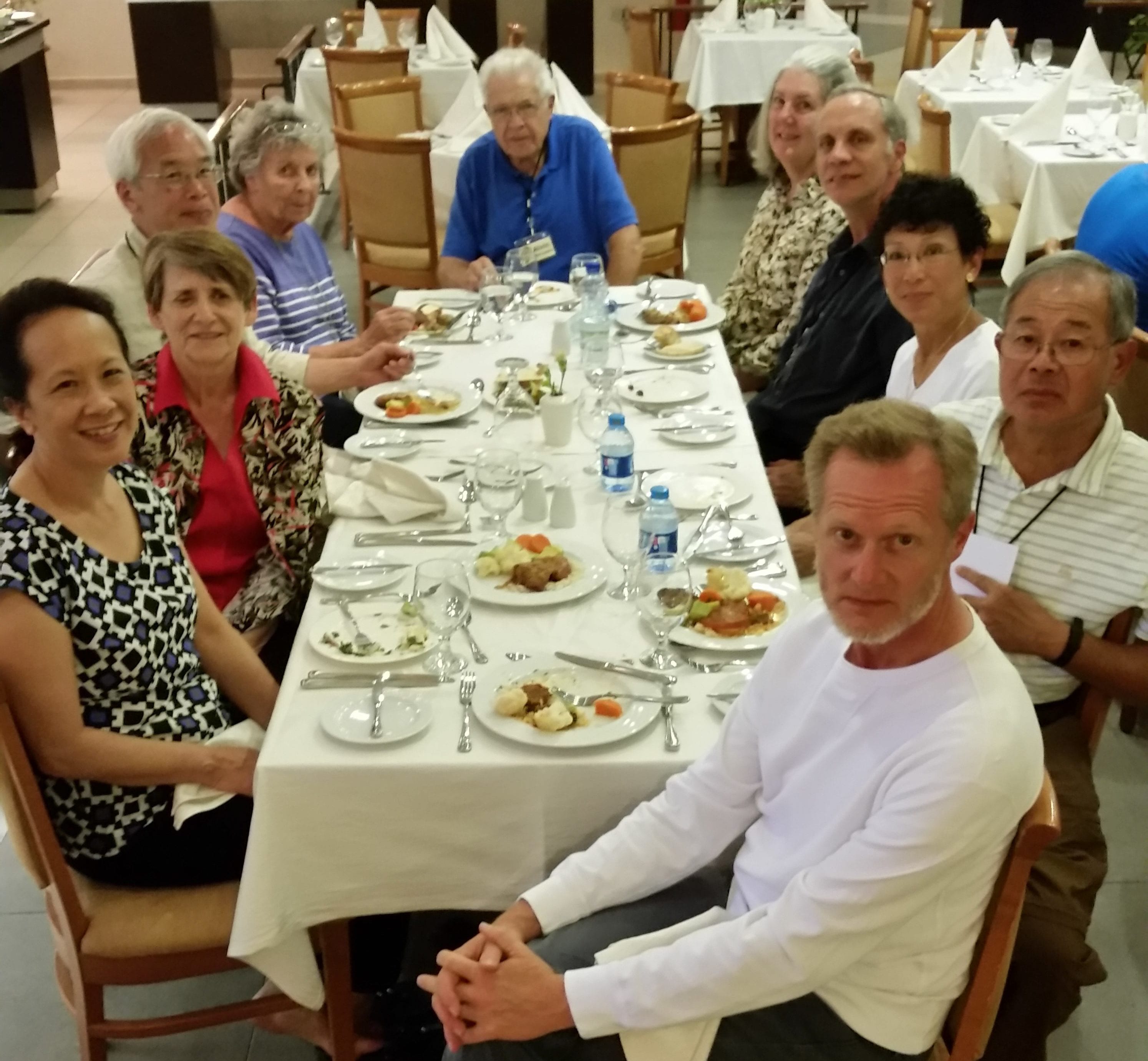
Petra Treasury
Today we visited Petra, capital city of the Nabataeans, an ancient people who roamed the Middle East for hundreds of years before settling in the Shara mountains east of the Dead Sea in the fourth century BC. They thrived as traders for several centuries, avoiding conquest by every other power because their city was so difficult to find. By the time the Romans located it, the Nabataeans had become powerful enough themselves to convince the Romans to make a treaty with them. At its height, Petra had an estimated population of 25,000. In 749 AD, a tremendous earthquake destroyed much of the city. Survivors scattered and never returned, eventually integrating into other Arab cultures and peoples. Century after century, sand sifted over the rubble and Petra became little more than a memory; only a few nomads knew where it had been. Today, it is occupied by Bedouins, some of whom live in caves that once were Nabataean dwellings and tombs.

Ancient Nabatean tombs

The road into Petra
Most people, including the two of us, thought Petra consisted only of a few ancient tombs carved into the red sandstone mountains, as pictured in Indiana Jones and the Last Crusade. The tombs are the most significant component of the site, largely due to their monumental size and the fact that there are a lot of them, but the marketplace, the royal residences, and various religious sites also have emerged from the sand, thanks to several teams of excavators. After having been lost to history for more than a millennium–few knew of its existence, let alone its location–Petra was rediscovered in 1812 by the Swiss explorer Johannes Burkhardt, who disguised himself as a Bedouin to gain entrance. Only in the last few decades, however, have real efforts been made to excavate the site, preserve its treasures, and open it to tourism.
Our hotel is literally only a few feet from the main entrance to the historic complex, so within five minutes of gathering after breakfast, we were inside the gate and hiking along a well-trod path through scenery that looked a lot like that of Arches and Zion National Parks. Running alongside the footpath and separated from it only by a low curbstone was another path for horses, donkeys, and the occasional motorized vehicle. It wasn’t long before we began to notice tombs cut into the sandstone hillsides, some decorated, others unadorned. Zaid stopped the group a few times to brief us on Nabataean history and point out various styles of tomb decoration. Since the Nabataeans traded widely–even with people as far away as India and China, they borrowed architectural design features from many other cultures. A single structure might display Egyptian, Hellenistic and Roman influences.

Zaid briefs us on Nabataean culture

An Egyptian-style obelisk tomb

A stepped tomb

Water troughs carried water into the city
After walking about a mile and a half, we reached the entrance to the Siq, the narrow gorge that provides visitors with the most dramatic entry into the center of ancient Petra. The Siq was pretty much buried by centuries of blowing sand until the 1970s. Now, it’s possible to see remnants of a sophisticated water delivery system along its winding length. There is a long, open trough to carry water for animals and irrigation, and a separate, closed system of clay pipes for drinking water. The elevation and angle of each conduit was carefully calculated to ensure an even water flow and avoid the buildup of too much pressure. Despite having started out as simple nomads, the Nabataeans certainly managed to develop some complex engineering techniques.

Shrine to Doshara and Uzza
Zaid also pointed out some interesting sculptures along the way. One was a religious shrine to the Nabataean god Doshara, who for some reason always is depicted with square eyes and no mouth; his mother, Uzza, is represented at his left. Another was the carved remains of a larger-than-life camel caravan

Remains of a sculptured merchant (right) with his camel caravan

The Siq

Our first glimpse of the Treasury
After we had walked through the narrow Siq for another mile and a half, Zaid asked us to line up two abreast, place our hands on the shoulders of the person in front of us, and then close our eyes.
“I’m going to count to ten in Arabic,” he said, “and after each number, you take a step as you say it back to me in English.”
When we got to ten, Zaid told us to open our eyes. Directly in front of us, just visible through the narrow slit at the end of the Siq, was the famous Treasury. The morning sun beyond the shadowy ravine was setting its red sandstone carvings ablaze–a sight we’re unlikely to ever forget.

At least one floor below current ground level awaits excavation at the Treasury

Burial chambers inside a tomb

Costumed “soldiers” guard the Treasury
Hundreds of tourists who must not have stopped along the way to listen to a guide were already milling about, creating an atmosphere like that of a bustling marketplace. Indeed, many locals were selling their trinkets and wares from makeshift stalls, while others accosted the tourists more directly, hoping to entice someone to ride their camels, horses, and donkeys.

The Palace

Place of worship inside the Palace
Zaid explained that Petra’s Treasury is not a treasury at all, but a monumental tomb. It acquired its nickname after rumors began circulating that the huge urn located high above the central doorway contained a fabulous treasure. Robbers took potshots at the urn, hoping to break it open, but alas, they succeeded only in creating bullet holes in the solid rock.

Amphitheater
After all our cameras had finished clicking in front of the Treasury, Zaid and Jim herded us farther along the main route through the complex. At this point, the high stone walls of the city open up into a wide valley. On the right side is a long avenue lined with four more monumental tombs, each created in a very different architectural style. All four are multiple stories high and anywhere from fifty to a hundred feet wide. The most magnificent of the four is the five-story Palace Tomb, which dates from the second century AD. Obviously, the Nabataeans wanted their leading citizens to go out of this world in style.

A portrait of King Abdullah reigns over a souvenir shop outside the Palace

Lynn and Emery take a break

Mark resting

Central area of Petra

Floor mosaics inside the Byzantine church
After the Avenue of the Royal Tombs, we traversed the mountainside in order to get to the ruins of a fifth century Byzantine church. On the floor of the church are some very interesting mosaics depicting a host of animals, both familiar and strange. The site also includes a baptistry built in the shape of a Greek cross, obviously meant for baptism by immersion–although big enough only for infants or small children. It is believed that a rogue priest who had rejected the Nicean Council’s changes to the rite of baptism must have come to this outpost and continued to immerse people, as had John.

Byzantine baptistry

Lunch break
After visiting the church, we took a break for lunch. Having learned on our previous trips that it is advantageous to discreetly pack a lunch from the breakfast buffet (which, outside the U.S., usually includes an assortment of breads, cold cuts, hummus, fruits, and vegetables as well as standard breakfast fare), Michael and Nancy were already prepared with boiled eggs, stuffed pita pockets, and fruit—as were a few other members of the group who had observed our ingenuity and decided to follow suit. From the terrace where we stopped to eat, we enjoyed a good view of the marketplace and the great temple where the ancient Nabataeans had gone about their daily activities.
We needed the lunch break both to recover from our morning hike and to gird up for our next challenge: a nine-hundred-step climb to the Monastery. More than half the group opted to ride donkeys up the steep, narrow trail, but the rest of us decided to trust our own knees and feet. What Jim had described as “steps” were only sometimes like those in an old, worn staircase; more often, they were simply piles of irregular stone blocks, with no handrails.
The Monastery near the top is one of the largest monuments in all of Petra, dating from the second century AD. Like other misnamed structures in Petra, it was not intended as a monastic retreat, but rather a place of meeting and discussion for religious associations. After a few dozen additional steps we made it to the summit, where we were rewarded with a magnificent view of the entire area.

The climb to the Monastery

Emery opted to ride a donkey up the 900 steps

View from the summit, looking toward Aaron’s tomb

The gorge up to the Monastery

The Monastery

Above the Monastery
Knowing that we had a nine-hundred-step descent ahead of us, we found a place in the shade to rest for a while before heading down. Having been warned that riding down a mountain on a donkey is more challenging than riding up, most of our group joined us on foot. (Indeed, a woman from another group who passed us on a donkey on the way down looked so uncomfortable and was moaning so loudly that we wondered whether she was injured.) Nancy found that conversation with her new friend Ann made the descent much less tedious. A herd of saddled camels was waiting for our group at the bottom of the mountain so we could ride the mile and a half back to the Treasury. Nineteen Americans in caravan must have made quite a sight because we were digitally captured by many tourists we passed along the way. Although riding on a camel had been described to us earlier today as “very smooth,” Nancy had to disagree. Her camel decided that he (or she—we didn’t inspect that closely) wasn’t content with his or her position at the back of the pack and kept pushing ahead, even when it meant trying to pass between two donkeys that were chained together. (Yikes!) Since Nancy had no idea how to control the beast, all she could do was hang on to the saddle horn and hope for the best. It was possibly the only occasion when she had started out behind Michael in a separate vehicle and managed to beat him to their destination.

Our camel regiment

Michael of Arabia

Nancy the Nabataean

Elephant carved into the sandstone
When we dismounted at the Treasury, a lot of locals were on hand—or in our faces—to offer us rides back to the entrance in their rattletrap buggies or on the backs of their beautiful Arabian horses (“Very good price! I make you special deal!”) but we resisted. By the time we got back to the hotel nine hours after leaving it, Michael’s Fitbit had registered 25K steps, 11.3 miles, and 145 stories climbed. Totally exhausted, several of us collapsed around a table on the patio outside the bistro to relax with a drink and enjoy the camaraderie that has begun to develop within our group.

Relaxing on the Guest House terrace

Trip companions: Marguerite, Sue, Brian, Marilyn, Al, Lynn, Mark, Cyndy , Luke, Rusty
The dinner buffet in the hotel’s dining room offered what seems to be the standard array of Middle Eastern fare: assorted vegetable salads, rice, potatoes, eggplant, lamb, and chicken—most seasoned with mixtures of spices we don’t often encounter in the U.S. The dessert table included a variety of pastries, custards, and fruit. After filling our plates several times, a group of tired and sore hikers were more than ready to call it a night.

Most of the rest of the group: Kevin, Nancy, Emery, Ann, Mark, Stephanie

Dessert sampler
Leave A Comment